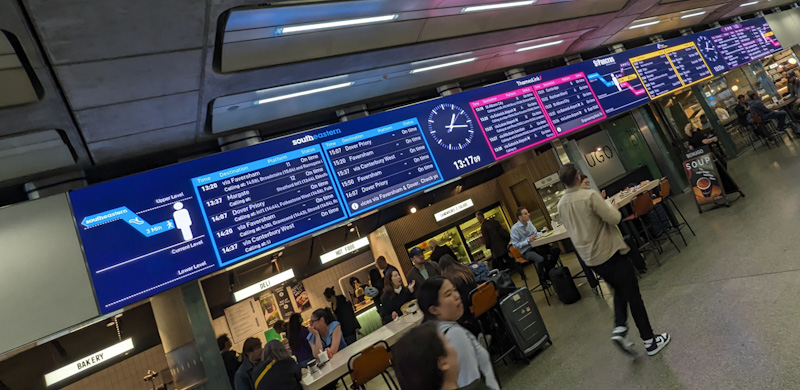A new full colour main board information display serving all platforms at London St Pancras International is helping with passenger management, customer experience, and demands on staff in the station.
St Pancras International is actually four stations in one, covering operators East Midlands Railway, Eurostar, Govia Thameslink Railway, and Southeastern.
Passengers, particularly infrequent and overseas ones, have always found it difficult to navigate the station. The new display was developed to help improve their experience.
A large amount of pre-deployment research and consultancy was undertaken prior to embarking on implementation. The board has been clearly split into the four distinct station areas providing train information at a level that is required for its location. The main aim of the display is to try to navigate people to their “station” in a timely and efficient manner, so it uses colours and dynamic maps to achieve this.
Infotec was responsible for the implementation of this unique data presentation and held meetings and workshops with the various stakeholders at the station (HS1, Network Rail, Eurostar, Southeastern, EMR and GTR) to achieve the presentation that worked best for the passengers.
TFT, full matrix monochrome LED, and full colour LED were considered, with the latter proving to be the preferred choice due to its innate flexibility in terms of presentation.
The new RGB display designed and built by Infotec and installed by CIS services measures 21m x 1.5m, the second largest rail display in the UK behind Victoria , providing a screen with a resolution of 7056 x 504 pixels.
In terms of the display hardware, Infotec mechanical engineers were able to design a solution that re-uses the existing support structures, minimising environmental impact and costs.
One of the key challenges was bringing the different data from the four stations’ systems into one display. This was achieved by sophisticated network configuration and clever feed management software on the display. The result is what appears to be four big displays but is actually just one.
Being one display means that there is a single point of failure, so Infotec has deployed unique hardware and software tools to ensure the display gives St Pancras the highest availability possible. These technologies include hot backup controller, redundancy power supplies, and a looped data transmission system. This allows the displays to be fault tolerant, providing a high level of performance even during fault conditions.
These types of RGB display provide infinite presentation options for the client, but with great power comes responsibility. Therefore, Infotec uses its unique tsPlayer software and Javelin CMS system to allow users to switch between pre-configured and approved templates quickly and seamlessly.
This allows the station operations team to instantly change information presented to passengers, dependent on the operational needs of the station, effortlessly allowing staff to concentrate on managing what might be real time issues and incidents at the station or on the railway line.
Driving massive RGB displays requires considerable processing power and this is where Infotec’s MC-CPU2 controller comes to the fore. This is a fully redundant controller built with dual processors that operate in tandem and, using smart technology, talk to each other to ensure the processor is in optimum condition when driving the display. Using Ethernet, 4G or Wi-Fi communications, the processors can accept external data from various sources and feed information back to the Javelin CMS system and use the data to manage the display hardware. This controller is the heartbeat of the P4050 control box.
Controlling such large amounts of power is not easy and is why Infotec created the P4051 for RGB LED mainboard applications. The P4051 allows larger mainboards to be started up gently to ensure there is no dramatic pull on a station’s power. It can also monitor power usage and feed this information back to the user.
From the passenger point of view, this now-installed display has been very well received. Passengers have been observed adjusting their behaviour in reaction to it, finding their platforms much more easily than previously. This is helping to prevent unnecessary crowding and constant time-consuming questions to station staff.
